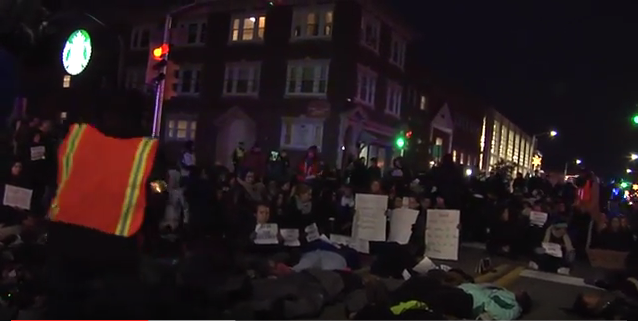Policing and Race in Lower Merion
The New York Times reported in 2014 on the vacated 1944 murder conviction of a 14-year-old black boy, George J. Stinney, “the youngest person executed in the United States in the last century.” Stinney was convicted of the murder of two white girls in a trial that took less than a day, and was executed only three months after the day of his arrest.
Circuit Court Judge Carmen T. Mullen’s decision to vacate, or legally nullify, the conviction was not based on the merit of the case but because “[t]he prosecution had failed in numerous ways to safeguard the constitutional rights of Mr. Stinney, who was black, from the time he was taken into custody until his death by electrocution.”
In light of the 2014 police killings of Eric Garner and Michael Brown, along with other notable cases where a white police officer killed a black suspect, a reasonable person may ask the question, “Has much about the justice and police system changed in the last 70 years?”
From Stinney’s case in 1944 to the cases of Garner and Brown in 2014 and many others, police and judicial racism against black citizens blights the United States’ national history. Closer to home, a history of racial profiling allegations exists in the Lower Merion Township, perhaps less violent or high-profile than that of Philadelphia or national breaking cases, but no less important.
In 2011, Officer Kerry Godbold accused the Lower Merion Police Department of racially biased hiring and promotion policies, which further consultant investigation found to be untrue. In January 2015, Wynnewood resident Deborah Saldana speculated that the police stop of two African-American snow shovelers was racially motivated, which the police department denied on the basis of previous illegal solicitation stops.
Both of these incidents were covered in Harriton Banner reports. According to a 6ABC report, a February 2015 meeting between residents and police gave no further satisfaction towards ending a legacy of tension.
Data and coverage of police bias events on the national and even local scale abound, but we wondered what stories we would find within our own school. In order to learn more, in December 2014, we interviewed two Harriton focus groups, one composed of ten black students in the POWER program, and the other of ten white students in Mr. Crooke’s journalism class.
The primary question was whether any of the students had been stopped by police. Though the groups were small and we were unable to account for the exact reasons students had been stopped, the numbers between the races were quite different: Eight of the ten black students had been stopped, while two of the ten white students had experienced similar treatment.
Matt Powell, then a Harriton senior, had on a black hoodie and got stopped across Lancaster Avenue. A white woman had become frightened, but in remembering, Powell wasn’t sure if it was because he was wearing all black or because he is black. Ethan Anderson, also a former senior, got stopped once while biking.
Savannah Brown, then a junior, reported that she was stopped and questioned by law enforcement when walking home from a friend’s house down the street. Later in the interview, Brown shared that she has multiple relatives who are cops, and although she does not hold any resentment or suspicion toward them, she still believes that some of their colleagues are doing wrong.
She was with Chris Fulton and Robyn Clark when, as Fulton described, the three students were stopped as they crossed a street. The officer told them not to jaywalk and said “Don’t do it again” to Fulton but not to Clark and Brown. Fulton felt uncomfortable, like the stop was “politically incorrect.”
After explaining about the details surrounding their stops, some students expressed discomfort about speaking to the police when approached. China Griffin, a former senior, mentioned that when she feels challenged, she can become defiant. In order to avoid confrontation, she will strategically not speak to police when they speak directly to her.
Also concerning to students is the lack of officers of color in the township. Powell commented that he has seen very few black officers and wondered if there even were any in the area. Out of the 136 officers currently on the LMPD force, five are black, and not much has changed since 2011, when, during Officer Kerry Godbold’s bias charges, three out of 135 officers were black.
When asked about how big a role systemic racism plays in their relationship with law enforcement, students made references to recent crimes committed by whites and their media treatment.
Jabree Stewart, then a junior, remarked, “I think it’s the fact that the media didn’t get into how bad… white people committing crimes [like] the Colorado movie theater shooting and Casey Anthony really were and are. And when a black person is involved, it becomes a crime. It just keeps happening repeatedly; there is just no justice.”
Movements like Black Lives Matter have sought to address these types of issues between the black community and law enforcement, but there is still work to do. When asked how to promote unity between black students, the focus group suggested the creation of black empowerment classes (similar to POWER) for younger students, starting in elementary school.
To get a different perspective, we reached out to the Superintendent of the Lower Merion Police Department, Michael J. McGrath, for an interview.
According to Supt. McGrath, in Lower Merion Township, the police respond to around 100 reportable incidents each year. These reportable incidents can occur for a variety of reasons, such as pedestrians’ reports of suspicious activities, disturbances between neighbors, or abandoned cars.
“First thing is to think about the reason for the stop. You have to have a justifiable reason for stopping people. Was the encounter positive, negative, did the person drive through a stop sign?”Supt. McGrath said. During training, officers are taught to de-escalate stressful situations using approaches such as verbo-judo. “This tactic aims to deflect the person’s anger and get them to focus on the resolution of the problem.”
When asked about the protocol police use when approaching people,Supt. McGrath explained that “behavior of the person is what drives you to stop people. If you were to stop people based on their gender, their race, perception of their ethnic background – that would not only be illegal, immoral and unprofessional [but also] it’s not something police officers do here. Certainly it’s not something police officers are trained to do.”
Aside from stop protocol,Supt. McGrath also spoke about the Lower Merion Police and Community Relations Committee. The committee acts as a communication channel between police and the community. A 2012 brochure explains that because “it can be intimidating to speak to a law enforcement professional”, the committee members (“your neighbors” – officers, residents, and pastors of local churches) can work for change on residents’ behalf.
“One of the tasks of the [Community Relations] Committee is to get enrollment for police officers and one of their jobs is to get more people of African-American descent to take the test. We like for the police department to reflect the diversity of the community,” Supt. McGrath said. This is an ongoing task: According to 2010 census data, 5.6% of Lower Merion Township residents were black. In 2015, 3.7% of the LMPD is black.
Many of the Harriton students we spoke to suspected bias in police encounters. However,Supt. McGrath stated that the Lower Merion Police Department’s priority is to protect everyone.
“In [the] Bryn Mawr Die-In protest, there was a lot of coordination in less than 48 hours notice. Two hundred people marched down in the middle of rush hour. Our entire job that night was to make sure no one got hurt. Police’s role in society is to protect everybody. But they [the officers] will protect themselves from injury because they have to go home to their families at the end of every day,” McGrath said.
While the police department’s goals – to protect Lower Merion residents and improve diversity in the force – are clear and Supt. McGrath’s intentions seem pure, black township residents and Harriton students perceive a different side of the police. As this local and national dialogue progresses, racial discrimination in America is placed front and center. Both sides on this issue seem willing to talk. Our own investigation for this article finds no solution.




